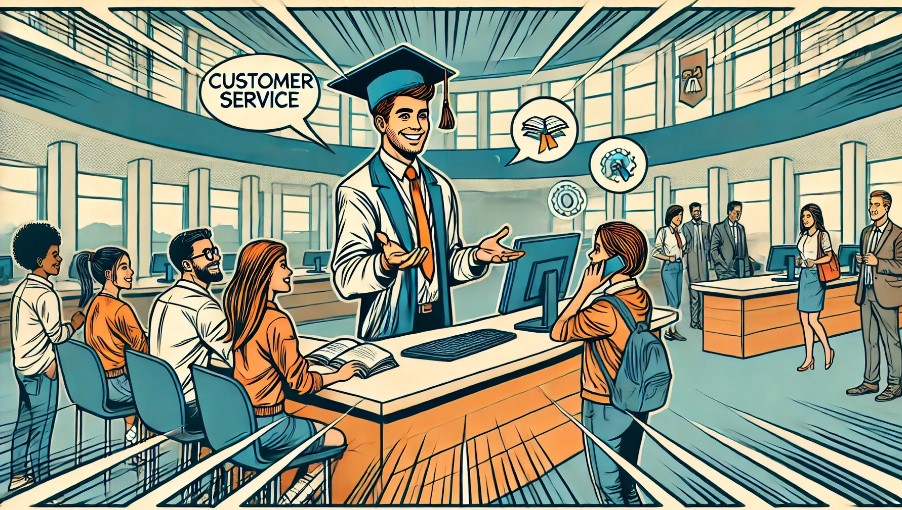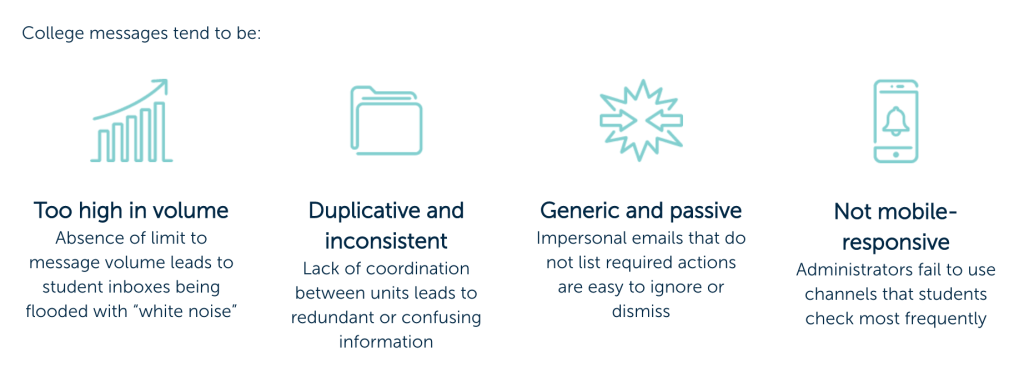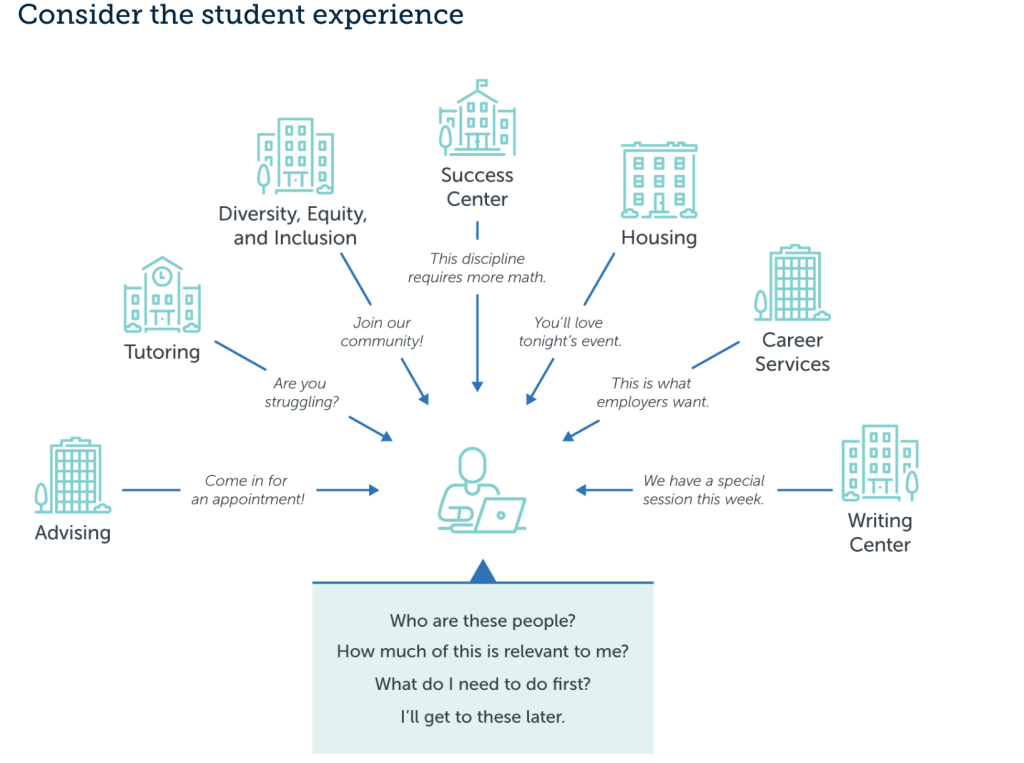My son is a senior in high school. All of you parents out there in the same boat know what that means: college choices. To help our kids make the right choice we take off on the journey with them. We sort through an ocean of emails from admissions. We coordinate campus visits. And we learn more about the world of higher education. We realize that our students, as well as us, the parents are customers. And customer service in higher education is as important as in any other business. College administrators and higher education professionals must treat students as customers. Then, they fulfill student expectations.

Why Is Customer Service Important In Higher Education?
Enrollment
Good customer service attracts new students to the university. Customers patronize businesses with supportive and responsive staff. And, similarly, students are more likely to choose a school that is known for those things. Poor customer service leads to students being confused about processes. On the other hand, treating students as potential customers and focusing on their customer experience can do wonders. Whether they need help with enrollment or academic support, offering services like write my term paper assistance can make a significant difference. Providing quality service ensures continued growth, student recruitment, and higher enrollment.
Reputation
A university’s reputation is closely tied to the quality of its customer service. Positive experiences can lead to word-of-mouth recommendations and improved rankings. Negative experiences can have the opposite effect. Convenience and efficiency of academic processes have a significant impact on college students.
Retention
Students and their families expect a higher level of service, requiring support throughout their journey with tools like Microsoft AZ-305 Practice Test Dumps. Good customer service is one of the key factors that contribute to student retention. When an institution understands students’ needs and works to meet them, it enhances the modern student experience. Excellent student experience support helps students stay focused on their Microsoft DP-900 Practice Test Dumps.
A recent report shows a significant association between students’ services and student success. (ScienceDirect)
Challenges of Customer Service in Higher Education
While the benefits of customer service in higher education are clear, challenges also arise. One major issue is addressing diverse student needs while maintaining efficiency, which requires skilled support staff. professional dissertation writers can also play a role in enhancing academic support services, ensuring students receive the guidance they need. Despite these challenges, customer service is an increasingly important aspect of the student experience. Institutions should strive to prioritize it in order to stay competitive.
Complex organizational structures
Higher education institutions can be large and complex. Universities contain various departments and systems. This can make it difficult to provide seamless customer service. Students may need to navigate multiple channels and points of contact.
Solutions:
In the words of the smartest man that ever lived, Elbert Einstein: “Simplify, simplify, simplify”
Have an intelligent person with a customer service mindset play an “undercover boss.” Have him or her go through all aspects of the prospective student experience. You will be amazed at what you’ll find you can simplify.
Diverse student populations
Higher education institutions serve diverse student populations. Their needs and expectations range widely. Providing effective customer service to such a diverse group can be challenging. After all, different students may require different types of support.
Solutions:
Create policies that encourage diversity within student populations. Promote diversity among front-line staff, administrative staff, academic advisors, and faculty members. Universities can work with outside organizations to promote diversity. They must find ways to fulfill the customer service expectations of various student personas. Institutions must serve students of all backgrounds. Discovering and fulfilling the needs of various student segments – first-generation students, non-traditional students, and international students – is key.
Limited resources
Higher education institutions often have limited resources to devote to customer service. This can make it difficult to provide personalized and timely support to students.
Solutions:
1. Look for alternative funding
One solution to limited resources is to…find some additional resources. (Not trying to be captain obvious here, so hear me out.) The right motivation behind the tricky search might help.
It is important to understand that customer service in higher education is crucial. Students are customers. Excellent academic customer service brings tremendous benefits to their experiences. Finding additional resources to deliver better service should be a priority.
One way to solve the issue of limited resources at universities is to find ways to increase enrollment and, subsequently, revenue. Increasing funds available for scholarships and other financial aid through fundraisers could help. The development of new and innovative ways to offer educational programs can also help.
Check out this paper from InsideTrack and Harvard Press on reducing costs through student services.
2. Tech and Automation Implementation
Undoubtedly, finding additional funding is difficult. But there are alternatives, including technological innovations. New developments of AI in customer service deliver more options. While many higher education processes require human interactions, some things can be automated. Virtual assistants, better online self-service options, communication cadences, chatbots, and other tech can help.
The pandemic taught us that visual education support is not only possible, it’s now essential. Enrollment processes, communication practices, housing, and health services should take place in a convenient and efficient manner.
Related Read: Fresno State Navigates the Pandemic to Better Serve Students
One of the most affordable, and effective ways to do that within the entire institution is tech use.
Tools for Customer Service in Higher Education
Preferred Student Communication Channels
“Communicating with schools digitally is the most important support factor for prospective students.” (Comm100)
A recent prospective student study shows that students seek digital communication experiences with college admissions consultants. To ensure service excellence, these experiences must become part of academic standards and processes. Solutions like a robust parent communication app, such as illumine, which streamlines communication between educational institutions and families, can significantly enhance engagement and satisfaction from the very start of a student’s journey.

Some key findings of the study show the following:
- 98% of students agree that the quality of support is an important factor when choosing a school.
- 88% of students want the option of using different channels to connect with schools.
- 59% of students are less likely to engage with a school if it takes more than 30 minutes to get a response to their query.
- 95% of students are open to receiving support from a chatbot.
It’s clear that prospective students favor digital experiences. And so, focusing on digital channels should be a priority for higher education institutions.
In order to accomplish this shift successfully, those channels must operate at near-perfect quality. It must provide students with the answers they need quickly and accurately.
Optimizing Digital Communication Channels
Create a seamless stream of communication between all the university departments and its students. It’s a big and important step towards a better student experience.
Start with identifying and addressing institution-specific challenges. Generally, higher education communications face the following drawbacks.

Omnichanneling Student Support
As we can see, duplicate, numerous, inconsistent, and generic messages downgrade higher education customer service. Creating an omnichannel system then, can address most of these issues.
Advice on how to find a fitting omnichanneling solution runs abundant. The first step is to determine the needs of the students. Equipped with that information, a higher education institution can implement a solution that keeps all of the student information in one place.

CTA: Omnichannel Solution for Your Higher Education Institution
Personalization
When an institution provides personalized service, it builds relationships and connections with the student body. Customer satisfaction depends on personalization in the business world. When students don’t feel like a number, but as a member of a community, they have better chances for success. In other words, personalization creates happy students.
To implement personalization practices, collect student feedback. Conduct surveys among current and prospective students. Before graduating students receive their college degree, ask them to reflect on their college experiences.
Knowledge Base
All digital channels depend on one crucial component to be effective: internal and external knowledge bases. Having up-to-date, helpful information on a college’s self-service portal can slash your inquiry volume.
You will need at least five resources assigned to this project – three writers, one editor, and one manager. Adequate knowledge base management can lead to major communication improvements.
Once you have a top-notch knowledge base out there, all of the digital channels can reference it. From then on, automated and human support users can communicate the information through every channel.
Knowledge Base is only important for customer service training. This is true for both, the employees working in the field and those who provide customer service online.
Bottom Line
Treating students like customers in the education sector can go a long way. Aspects of customer service can take your institution to the next level. Just as successful business models in the corporate world focus on customer service, so should education providers. Prospective and current students must experience the school’s student-centric service.




